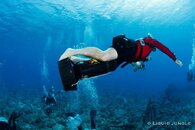Juardis
Contributor
I need help. And a lot of practice. My wife and I took our OW certification dives yesterday and I seriously screwed up my safety stop. We were at 30' for about 20 minutes when our instructor called for us to surface and stop for a 3 minute safety stop. So I ascended to 15 feet....and kept ascending. I was going slow (maybe not slow enough), breathing continuously, but I couldn't stop. I hit about 4', then remembered to dump all my air. So I sunk....down to 25 feet. I'm trying to control my buoyancy by breathing only (no BC inflates/deflates) so I'm breathing frantically trying to control my ascents/descents. I wound up having to use the inflator button anyway, which probably contributed to my problems.
Anyway, long story short, I spent about 5 minutes yo-yoing between 5 feet and 25 feet until my ears wouldn't clear. So finally I slowly surfaced.
On our 2nd dive we stayed at about 20 feet the entire time so it was relatively easy to maintain our safety stop at 15 feet, but going from 30 to 15 proved more difficult than I anticipated.
So here's the question. How do you practice this in a 15 foot pool? Or can't you?
Anyway, long story short, I spent about 5 minutes yo-yoing between 5 feet and 25 feet until my ears wouldn't clear. So finally I slowly surfaced.
On our 2nd dive we stayed at about 20 feet the entire time so it was relatively easy to maintain our safety stop at 15 feet, but going from 30 to 15 proved more difficult than I anticipated.
So here's the question. How do you practice this in a 15 foot pool? Or can't you?




